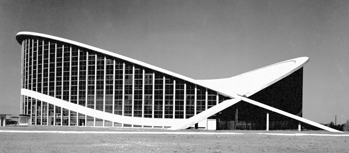Dorton Arena
The North Carolina State Fair Arena, completed in Raleigh in 1953, was dedicated as the J. S. "Doc" Dorton Arena on 16 Oct. 1961. Dorton, a retired veterinarian, served as State Fair manager from 1937 until his death in 1961. The arena was built to serve agriculture, industry, commerce, and the public as a year-round center for educational, inspirational, and recreational events. In addition to its use during the State Fair each autumn, the arena functions as a statewide exhibit center for trade shows and accommodates conventions, meetings, banquets and exhibitions, and circuses and other entertainment attractions.
The elliptical arena is 300 feet in diameter, with a central concrete floor 221 feet long and 127 feet wide at the widest part of the ellipse. It contains 4,750 permanent opera-type chairs and 360 box seats for a capacity of 5,110. About 4,400 portable seats can be installed on the floor when a stage is used, increasing the total capacity to 9,150. The metal-asbestos, saddle-shaped roof is suspended in a network of cables extending crosswise from the 90-foot parabolic arches. Fourteen-foot-wide arches, reaching a maximum height of 90 feet, cross each other at about 26 feet above the ground and extend into a tunnel below the surface of the east and west ends. Tension cables equalize the weight of the roof, with 14 two-inch strands connecting each end of the parabola through the stress tunnel. The roof, so suspended, eliminates any necessity for structural steel supports and presents no visual obstructions from any seat. The exterior walls consist of translucent heat- and glare-reducing glass above the two ground-level lobby areas. These and two lower-level concourses provide about 25,000 square feet on the arena floor.
Matthew Nowicki conceived the distinctive structure, a daring exercise in architectural design, while head of the Department of Architecture of North Carolina State University. Shortly after accepting the arena commission, Nowicki died in an airplane accident near Cairo, Egypt. His friend, architect William Henley Deitrick of Raleigh, took over the project. The arena, it has been said, serves as a memorial to a potentially spectacular career cut short. At the centennial celebration of the American Institute of Architects in 1957, it was named one of the ten buildings of the twentieth century most likely to influence future architects.
References:
Catherine W. Bishir and others, Architects and Builders in North Carolina: A History of the Practice of Building (1990).
James Vickers, Raleigh: City of Oaks (1982).
Additional Resources:
Inventions in North Carolina, Dorton Arena, North Carolina Museum of History: http://www.ncmuseumofhistory.org/collateral/articles/Dorton.Arena.pdf
Dorton Arena, NC State Fair Grounds: http://www.ncstatefair.org/facilities/dorton.htm
Dorton Arena, extended history, NC State Fair Grounds: http://www.ncstatefair.org/facilities/dortonhistory.htm
1 January 2006 | Williams, Wiley J.